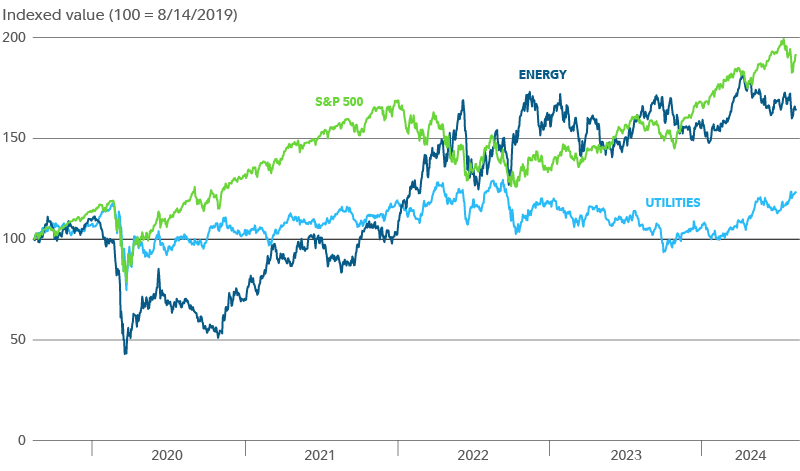Stocks in the energy and utilities sectors sit at the nexus of ever-changing energy costs, surging global power demand, shifting energy production dynamics, and a range of other factors. As markets have heated up to record highs, investors may want to consider that these stocks appear to represent one of the best values in the market today based on earnings multiples.
Will energy power up?
While a 7% year-to-date price gain for energy stocks thus far in 2024 might be considered strong most years, that compares with a 17% gain for the S&P 500 year to date. This follows a 3% decline for energy stocks during 2023. Over the longer term, energy (and utilities) have underperformed the S&P 500, and have far underperformed more cyclical sectors.

Why have energy stocks underperformed recently?
Energy is a competitive, capital-intensive sector that tends to rise and fall with the broader economy. Even though US GDP growth has been robust, lingering potential recession concerns have contributed to the volatility in energy stocks over the past several years. There has also been a clear investor preference for tech and other high-growth sectors. These factors, among others, have helped put a cap on momentum for energy stocks.
But there's a bright side. Because energy stocks have not run up as much as some other sectors during this bull market, and because the sector's fundamentals generally remain sound, it is currently one of the most attractively priced. The price-to-earnings (P/E) ratio for the S&P Energy Select Sector Index is low (i.e., more attractive) relative to the current S&P 500 P/E ratio as well as to its own long-term historical P/E ratios. Additionally, dividend yields in the energy sector (as well as the utilities sector) are broadly among the highest across the market.
Maurice FitzMaurice, manager of the Fidelity® Select Energy Portfolio (
Fund top holdings1
Top-10 holdings of the Fidelity® Select Energy Portfolio (
- 25.1% – Exxon Mobil (
) - 6.0% – Cenovus Energy (
) - 5.2% – Schlumberger (
) - 4.9% – Chevron (
) - 4.7% – Marathon Petroleum (
) - 4.7% – Canadian Natural Resources (
) - 3.9% – Occidental Petroleum (
) - 3.8% – Valero Energy (
) - 3.8% – Cheniere (
) - 3.4% – Hess (
)
Another critical factor to consider when investing in oil stocks is oil prices (obviously). Energy stocks tend to rise when oil prices rise, and they tend to fall when oil prices fall. Oil prices have increased thus far in 2024, helping bolster most energy stocks (it's worth noting that US natural gas prices are down). Global investment in oil production has picked up a bit recently after remaining low for nearly a decade, but it will take several years for new supply to come online. That, plus multiple geopolitical conflicts across the globe, are reasons to think oil prices may have a floor under them.
FitzMaurice thinks that any potential changes in government policy are likely to play less of a role compared with slowed US oil production and OPEC market intervention. "This could keep oil prices supported in the $75 to $90 per barrel range," Fitzmaurice adds. West Texas crude oil traded near $78 per barrel, as of mid-July. "Key OPEC producer Saudi Arabia aims to maintain high oil prices to fund government spending priorities, and ongoing geopolitical tensions in the Middle East could lead to supply disruptions from some producers."
If you are interested in exploring the energy sector, here are 5 energy-sector common stocks from the Fidelity.com Stock Screener with a market cap of at least $56.4 billion, a dividend yield of at least 2.4%, and a P/E ratio under 14.6, sorted by market cap, as of August 15, 2024:
- Exxon Mobil (
) - Chevron (
) - ConocoPhillips (
) - Canadian Natural Resources (
) - EOG Resources (
)
A consideration when adding individual stocks to your portfolio is concentration risk within a particular sector or industry. Concentration risk is essentially putting your eggs in a single basket—if you are not diversified across the rest of your investments.
Power surge across sectors
Utilities are another power-related sector with attractive multiples and big dividends. Power prices have increased significantly in recent years, as surging global demand for energy has ramped up with Earth's population tipping past 8 billion last year. That could help underpin strength for utility stocks.
NextEra (
"There will be increasing investment by utilities in power generation—and grid infrastructure—and I expect that to be met mostly by renewables and natural gas," FitzMaurice adds. Other factors, including the near-term possibility of interest rates going down (a positive factor for the utility companies, which rely heavily on borrowing) and the sector's defensive characteristics as a bulwark against any potential economic slowdown, could make an electrifying backdrop for utilities.
Here are 5 utility common stocks from the Fidelity.com Stock Screener with a market cap of at least $10 billion, a dividend yield of at least 3.7%, and a P/E under 21.9, sorted by market cap, as of August 15, 2024:
- Duke Energy (
) - Exelon (
) - Xcel Energy (
) - WEC Energy (
) - Entergy (
)


